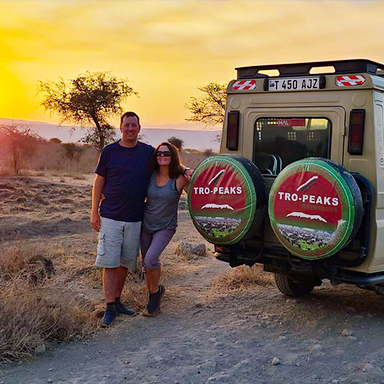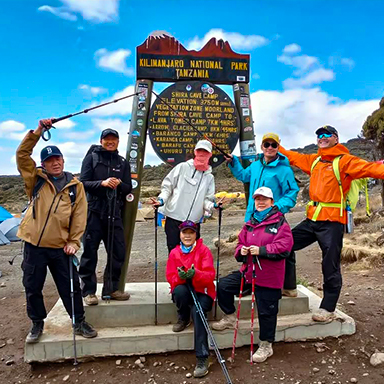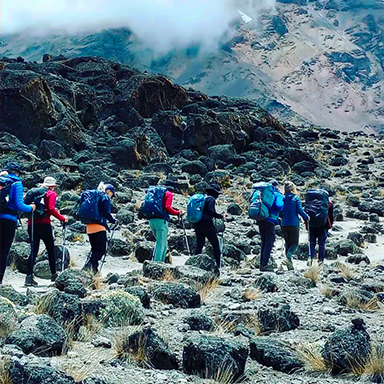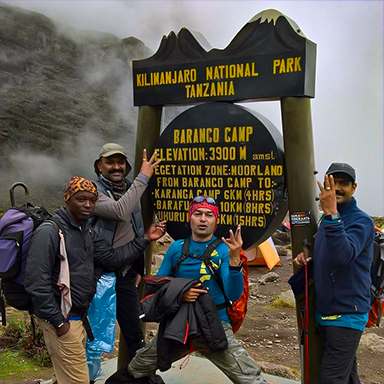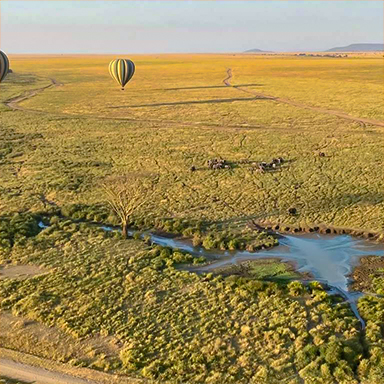Kilimanjaro Packing Checklist
In order to be safe and comfortable throughout your Mount Kilimanjaro climb, you’ll need to bring important gear and supplies with you. We have put together a comprehensive Kilimanjaro Packing list to help you prepare for your climb.
Kilimanjaro climbs come with a large team of people including guides and cooks, and porters to carry your main bag as well as tents, kitchen equipment, food, fuel, tables and chairs. While this makes it easier for you to conserve energy and focus on reaching the summit successfully, it does mean that there is a weight limit to stick to. It’s also important to be very aware of the welfare of porters during your climb, so not over-packing is key.
Duffle Bag
Porters are not allowed to carry more than 20kg in total and this allowance needs to include space for their own belongings. So make sure your bag does not exceed the weight of 15kg.
Day Pack
This is the bag you will carry every day on your back, so make sure it has room for essentials such as water bottles, spare layers and waterproofs, camera etc.
Dry Bags
Make sure all your contents are wrapped in waterproof bags to keep them dry. Use them also to store used clothes during the trek.
Your choice of sleeping bag and sleep accessories will depend on your personal needs and preferences.
Sleeping Bag
3 Season sleeping bags are sufficient for the warmer months but if you get cold easily, and especially during the colder months around October through the new year it’s better to upgrade to a 4 season sleeping bag or use a 3 season bag with a fleece liner.
Sleeping Bag Liner
Liners provide added warmth and a good fleece one will convert a 3 season bag to a 4 season bag. Silk is also warm and less bulky. We also recommend a cotton liner to keep your sleeping bag clean.
Sleeping Pads / Mats
These are not required for Kilimanjaro, but are an option for those who desire extra insulation for their sleeping bag. Inflatable Thermarests or lightweight Exped mats are fine but they tend to slide over the mattress, so a closed cell camping mat is actually the best.
Looking after your feet is important for mountain climbs. The right care and preparation will save you from pain and blisters, so cut your nails before setting off and keep feet clean and dry. Foot talcum powder is quite good too but remember to wash it off at the end of the day. Take some blister pads just in case and change socks every day.
Walking Boots
Leather boots are best, make sure they are well covered in dubbin to keep the water out. Fabric boots will get wet if it rains heavily but the goretex lined ones will stay dry in a shower. Boots should have proper ankle support and have a stiff midsole so the boot doesn’t bend too much.
Trekking Socks
Trekking socks for the early days will be fine – one pair per day for the first 5 days- but for the summit night a woollen mix is warmest, but check they fit comfortably in your boot with no tightness. Socks can be long or short.
Camp Footwear
Change out of boots when you get to camp and let them air out. Bring a pair of camp shoes such as trainers or lightweight walking shoes or sandals. You will also use these for toilet visits at night.
We lose half of our body heat through our heads, so keeping your head warm while trekking Kilimanjaro is essential. On the flipside, there’s also risk of sunstroke and sunburn with the intense UV rays at high altitude.
Buff / Scarf
The Buff® is ubiquitous on treks and climbs and is very useful to protect the face from sun and dust and wind. They can be made of stretchy thin material or fleece. You can use a scarf or snood equally well.
Sunglasses
Eye protection is vital, as the UV rays are particularly strong even in cloud. UV400 sunglasses are a must and try to take a pair that have side protection.Be careful of prescription glasses that change colour, they normally do not provide enough UV protection and the lenses often aren’t big enough to prevent the rays getting into the eyes.
Sun Hat
One of the biggest risks of climbing Kilimanjaro is exposure to the sun and possible heat stroke through the top of the head. A sun hat must be worn at all times if it’s sunny and if it has a brim all the better to protect the back of your neck.
There are no charging facilities on the mountain so come prepared to be self-sufficient with power.
Head Torch
This is essential for the summit night when you need your hands free for scrambling or using poles and also for going to the loo at night. There are many types available but something like the Tikka A would be adequate. Have one complete spare set of batteries for summit night.
Power Pack
There are no charging stations on Kilimanjaro so bringing a small power pack with USB cables is the smart thing to do, especially since phone and camera batteries tend to die quite quickly in the cold.
GPS / Altimeter
This is optional but very useful for tracking your progress. Some people use a satellite tracking device called a SPOT so people can follow their route at home.
Trekking Poles
These are very useful but especially for the descent which is on loose scree. Anyone worried about their knees should take a pair, preferably with suspension.
Flask
On summit night you will want a hot drink to keep warm and hydrated. The guides carry large thermos flasks but you may want to bring a half litre or one litre flask of your own.
Water Bottle
Make sure you have a bottle as you’ll need to stay hydrated. Platypus or camelbacks are fine too, but the tubes may freeze on summit day and must be insulated. Note that disposable plastic bottles are illegal.
Umbrella
These are very useful on the first day in the forest if it is raining hard and too hot to wear waterproofs, and on the second day if there is no wind. Higher up on windless sunny days they are again useful.
Hand Warmers
Ideal for those who have poor circulation or get cold easily. The charcoal ones that react with oxygen don’t work as well because of the high altitude and lack of oxygen in the air, but they are certainly useful for your hands inside your mitts on summit night.
Mosquito Repellent
There are almost no mosquitos on Kilimanjaro due to the height above sea level. However, there are mosquitos in Tanzania so repellent sprays are recommended for when you first arrive and finishing descending.
FIRST AID & HYGIENE
Our guides also carry an extensive first aid kit, a mountain shelter, oxygen bottles and a mask and a stretcher on every climb. We also have literature on the various drugs and also high altitude sickness for you to read. However you should still carry a personal first aid kit for minor complaints. There are no permanent showers or bathing facilities on Mount Kilimanjaro, but a bowl of hot water is available at camps for washing your face and hands. For larger groups, we can provide a shower tent with a bag of water warmed up by the sun. You can also ask the guides to provide a bowl of hot water for a wash in your tent.


